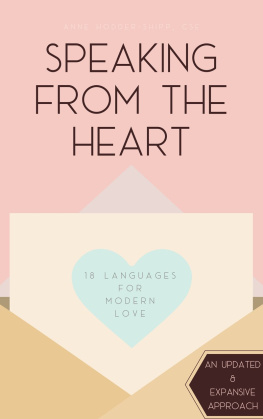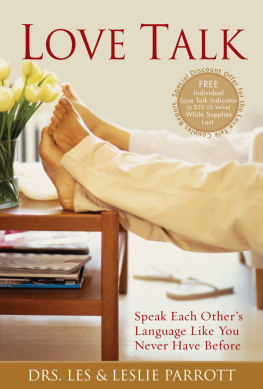SPEAKING TRUTH IN LOVE
Counsel in Community
David Powlison
New Growth Press
www.newgrowthpress.com
Speaking Truth in Love 2005 by David Powlison
All rights reserved. No part of this book may be reproduced, stored in a retrieval system or transmitted in any form or by any meanselectronic, mechanical, photocopy, recording, or otherwiseexcept for brief quotations for the purpose of review or comment, without the prior permission of the publisher, New Growth Press, P.O. Box 9805, Greensboro, NC 27429-0805.
Requests for information should be addressed to: New Growth Press, P.O. Box 9805, Greensboro, NC 27429-0805.
Scripture quotations are from the NEW AMERICAN STANDARD BIBLE . Copyright The Lockman Foundation 1960, 1962, 1963, 1968, 1971, 1972, 1973, 1975, 1977, 1995. Used by permission.
Italics in Scripture quotations indicate emphasis added.
ISBN-10: 0-9770807-14
ISBN-13: 978-0-9770807-1-7
Christian Living/Practical Life/Lay Counseling
To Dodie Powlison, my mother and a most companionable friend, with a lifetime of gratitude for your eminent good sense.
PREFACE
GOOD INTENTIONS
We pray for you always, that our God willfulfill every desire for goodness and the work of faith with power.
(2 Thess. 1:11)
Its hard enough to think right, but its harder to live right. This is a book on how we are to live together. What ought to be the quality and dynamic of our relationships with each other? What is right and true, good and loving, lovely and desirable? We want that.
This book is also about how we can live. Of course our achievements will be imperfect, halting, erratic. But we can do this to some measure by the grace of God. We can go forward in this direction and grow in these ways. Any progress at all is solid joy, lasting treasure, radiant wisdom. We want that.
This book is also about how we will live. When all that we can now barely imagine becomes reality, we will fully savor what we have already tasted. No eye has seen, no ear has heard, and no heart has imagined what God has prepared for those who love himyet he lets us glimpse, overhear, and catch a sense of things. We want that.
This book is about how we treat each other, how we work together, how we help each other. Its about constructive relationships: how we counsel and encourage one another. Its about what church really is: how we all grow up together. Pauls request early in 2 Thessalonians recognizes that even our desire for whats right counts. Its better to want whats right than to want whats wrong, or not to know whats right, or not to care. We may fall short of turning intention into action, but intentions matter. Even our willing of his good pleasure, wanting what is right, is something God works in us. In effect, we can ask, Our Father, please make our good intentions actually happen, for your sake.
This is a book of good intentions. A James Ward song puts it this way: Faith takes a vision, turns a dream into a mission. This book presents vision seeking realization in mission. I will describe a direction and trace out a few steps in that direction. Direction matters. In effect, we can ask, Lord, for your names sake, please make the work that faith imagines a reality.
COUNSEL AND COUNSELING
Speaking Truth in Love is the second in a series. It builds upon Seeing with New Eyes. That previous book was an attempt to think right. I sought to bring Scripture to life and to reinterpret common life struggles through Gods gaze. It was about counsel, the content of truth. This second book is about counseling, the process of love. Part I will wrestle out how to speak the truth in love in order to do counseling ministry well. Part II will hammer out ways to shape and reshape communities of faith in order to do church well. In other words, this second book describes living right. We will glimpse essential dynamics of relationship and sketch the shape of communities that pursue such relationships.
Its hard to do counseling ministry well. How do we converse with others to make the right kind of difference? How do we understand the problems of life so that we can offer real help? We all know that wise, mutual, life-changing counseling means that speaking the truth in love, wegrow up[speak] only such a word as is good for edification according to the need of the moment, so that it will give grace to those who hearencourage one another day after day (as Ephesians 4 and Hebrews 3 put it). But how do we do something so easy to say and so hard to do? A counseling model designs relationships and methods to facilitate the change process; it is counseling as well as counsel.
Its hard to do church well. Church so easily becomeswell, becomes church (you fill in whatever ruts are most familiar). But if Jesus is full of grace and truth, it must be possible to form communities more full of grace and truth. The flourishing of wise, mutual, life-changing counseling is one proof that everything else about church is accomplishing what its supposed to. Every counseling model entails a delivery system, a social structure. Ideas and practices inhabit institutions. The most magnificent institutional structure imaginable is a community living out how Ephesians 4 weds pastoral leadership with every-member mutuality.
This book is not an exposition of Ephesians 4or, more exactly, of the words we now identify as Ephesians 3:14 to 5:2. But that is the thought unit that most shapes these pages. Grab a handful of verses in either direction from Ephesians 4we might call it Ephesians 4+and you capture to perfection a half dozen questions that fill libraries with books. These questions ponder the dance between Gods immediate power and our significant choices, between our dependent faith and our active love, between individual experience and the dynamics of the social group, between leadership and mutuality within the social group, between the relationally destructive dynamics of sin and the constructive dynamics of gracious love, between remnant sin and emergent love. These are six perennially perplexing questions. Paul does not so much answer them as illustrate how the answers work out in reality. These words from Christ via his messenger will occasionally be visible, but they will always provide the living, invisible structure that informs this book. We might say that Ephesians 4+ forms the neuroelectrical grid, cardiovascular network, and musculoskeletal system for everything in the pages that follow. In that spectacular revelation, we witness the essential elements of a church functioning as a community characterized by the dynamics of fruitful mutual counseling.
Or we might put it the other way. Speaking Truth in Love seeks to recapture how the dynamics of fruitful mutual counseling characterize a church that functions as a community.
TABLE OF CONTENTS
PART I
SPEAKING TRUTH IN LOVE
I suppose that all of us who try to help people find ourselves marveling at how mere words, the simplest actions, and the most subtle interpersonal attitudes can have such profound effects on others. Human beings affect each otherfor good or ill. If we want to help, not harm, we must consider what affects others for good.
All of us have experienced how an insightful, humane voice can work for good in our lives. (And certainly all of us have experienced how false or callous voices have harmful effects.) It is a fine thing when another human being takes you seriously. Someone wants to know how you are really doing, listens to what you say, and cares enough to respond constructively, saying what is both true and helpful. By word and deed in relationship, one person truly helps another.
LOVE IN ACTION
Wise counseling embodies the human and humane impact of relevant truth. It gives a new perspective and opens up new choices. It both sustains and redirects. For decades, counselors of all stripes have debated the question: Is counseling essentially a matter of
Next page












